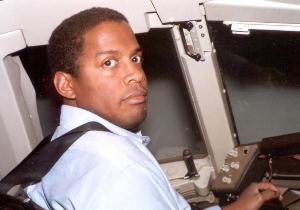How Hard Is It to Fly a 757 or 767?
The AirSafe Journal™
17 September 2001
vol. 1 num. 16
In the wake of the attacks at the World Trade Center and the Pentagon, it is clear that one of the key factors in the success of those attacks is that at least one member of each of the four teams of hijackers was a trained pilot. While there is some question as to the amount of flying expertise possessed these hijackers, there is no indication that any of them had the level of experience or qualifications of an airline pilot. Whatever their level of expertise, it was sufficient to guide three of the four hijacked planes to their targets, causing the deaths of thousands.
 |
Dr. Todd Curtis at the controls of a full motion 757/767 simulator |
Many people have wondered how it could be possible for relatively unskilled pilots to do this. This writer is in a unique position to answer that question. I am a licensed pilot of very limited experience, with just under 100 hours in small, single-engine training aircraft such as the Cessna 172. A few years ago, I had the opportunity to take a short course on the 757 that included classroom training, individual computer based training, and about five hours in a full-motion simulator. This high fidelity simulator was the same kind of that airline pilots use in their initial training or to simulate a wide range of emergency procedures.
After about a week of training, I was familiar with the layout of the flight deck and with the operation of the flight controls, autopilot, and navigation systems. As a result, flying the simulator was much less difficult than I had imagined at the beginning of the course. The most difficult part of the simulator training was takeoffs and landings. On the other hand, flying the aircraft in other phases of flight was relatively easy, even compared to flying a Cessna 172. Changing the aircraft's course, speed, or altitude was not very difficult when using either the autopilot system or when flying the aircraft manually. The flight control system made the aircraft rather responsive and made it easy to perform normal flying manuvers.
Given my experiences in the simulator, I feel that if I were to be put into a 757's cockpit in the middle of a flight on a relatively clear and sunny day, I would be able to change direction and altitude without any trouble. Given a basic knowledge of a region's geography and of available navigational aids, I would also be able to navigate well enough that I could find a major city and fly the aircraft to any major landmark in that city. Because the basic cockpit layout and many of the procedures used in the 757 are almost identical to those of the 767, I feel that the same would be true for a 767.
In short, I believe that any person who has earned a private pilot's license and who has access to the same kind of ground school and simulator training that I received could fly a 757 or 767 well enough to hit a large building. Given the wide availability of this kind of training, it would appear that the kind of terrorist actions that took place in New York and Washington could easily be repeated in the future.
http://www.airsafe.com/journal/v1num16.htm -- Revised: 24 May 2015